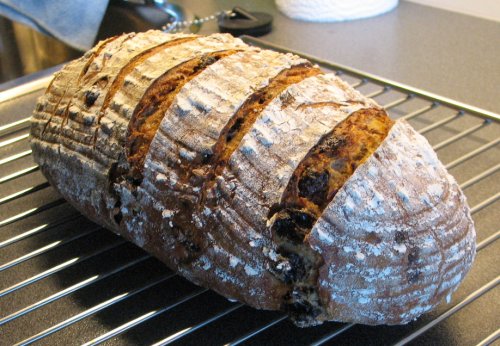Gluten Free Brown Rice Starter Success
Why Boosted Brown Rice Starter?
- Log in or register to post comments
- View post
- sharonk's Blog
Why Boosted Brown Rice Starter?
(You can, if you wish, skip all my mutterings. The recipe is at the bottom.)
My little Welsh grandmother was a gentle soul with streaks of stubbornness, impishness, and independence just below the surface. Born in Wales in the 1883 she sailed to America, with her coalminer father and her mother in 1894. By the time I knew her only her baking, and a light lilt in her speech hinted her origins; she had become American, through and through.
My oldest son bought a bread machine in 1988. A, Rube Goldbergesque device that, after a fashion, produced an oddly shaped loaf of bread reminiscent of a miner’s lunch pail: tall where it should be short, square where it should be round, and round where it should be square. Its white bread cycle produced a soft-crusted loaf, with a crumb akin to Wonder Bread. I don’t recall if it had any other cycle choices. I promptly lost interest in bread machines, and for the next decade remained a smug, hands-on baker.
...but bread is alright.
I wanted to experiment a little this week, so I decided to bake two new loaves. I think both turned out rather well, and I'll probably add them to the list of loaves I'm baking quite frequently. The first one is a loaf that goes remarkably well with most kinds of fruit, preserves, a wide range of cheeses and besides your dinner plate: A sourdough rye with toasted hazelnuts and raisins.

Curiouser and Curiouser
Recently, I was on the short-list--I don't think they had enough people show interest to ever have a long-list--for the editor's job on a carriage driving magazine . The organization's Executive Director interviewed me, via telephone. Among her many questions was one that struck a nerve, my pleasure nerve: "Dave, I don't get it," she said. "You're retired. You got the world by the a**; why do you want this job?"
Hamelman's Sourdough Seed Bread is basically a pain au levain made with rye and bread flour to which is added toasted sesame and sunflower seeds and a soaker of flax seeds. It has a crunchy, rather thick crust and a pretty dense crumb. Its flavor is delicious - mildly sour, even when cold retarded overnight, with well-balanced overtones from the seeds. Its flavor is not as complex as Hamelman's Five-Grain Levain, which is simply amazing, but it is a wonderful bread.
I finally remembered to take a camera with me while grocery shopping this afternoon. For almost two years now I've been thinking "Gotta remember to take a picture to show the other Loafers." So, finally, here goes.
I now get week by week repeated success with Hamelman's Vermont Sourdough which is our regular bread I bake each weekend. My take-home message to all sourdough newbies is to persist and pay attention to detail. It's tempting to skip and make do with estimates and a "she'll be right" attitude, but if I want consisency week after week with sourdough, I have to do all the below:
This is the first time to try this bread and first bread I have made from Bread Alone by Daniel Leader & Judith Blahnik. I wanted a nice loaf to go with a variety of cheeses and this made a nice choice...like it says thinly sliced it makes a nice compliment to cheeses. It's delicious, I think the grated walnuts in the dough, plus the fact that I have access to some very fresh nuts in my area made this bread even more tastier. The crust also has a very pleasing crunch, chew and lot's of flavor. The crumb was pleasing and
My favorite Semolina Bread.
The formula and procedures I used are here: Tom Cat's Semolina Filone (from Glezer's Artisan Breads)